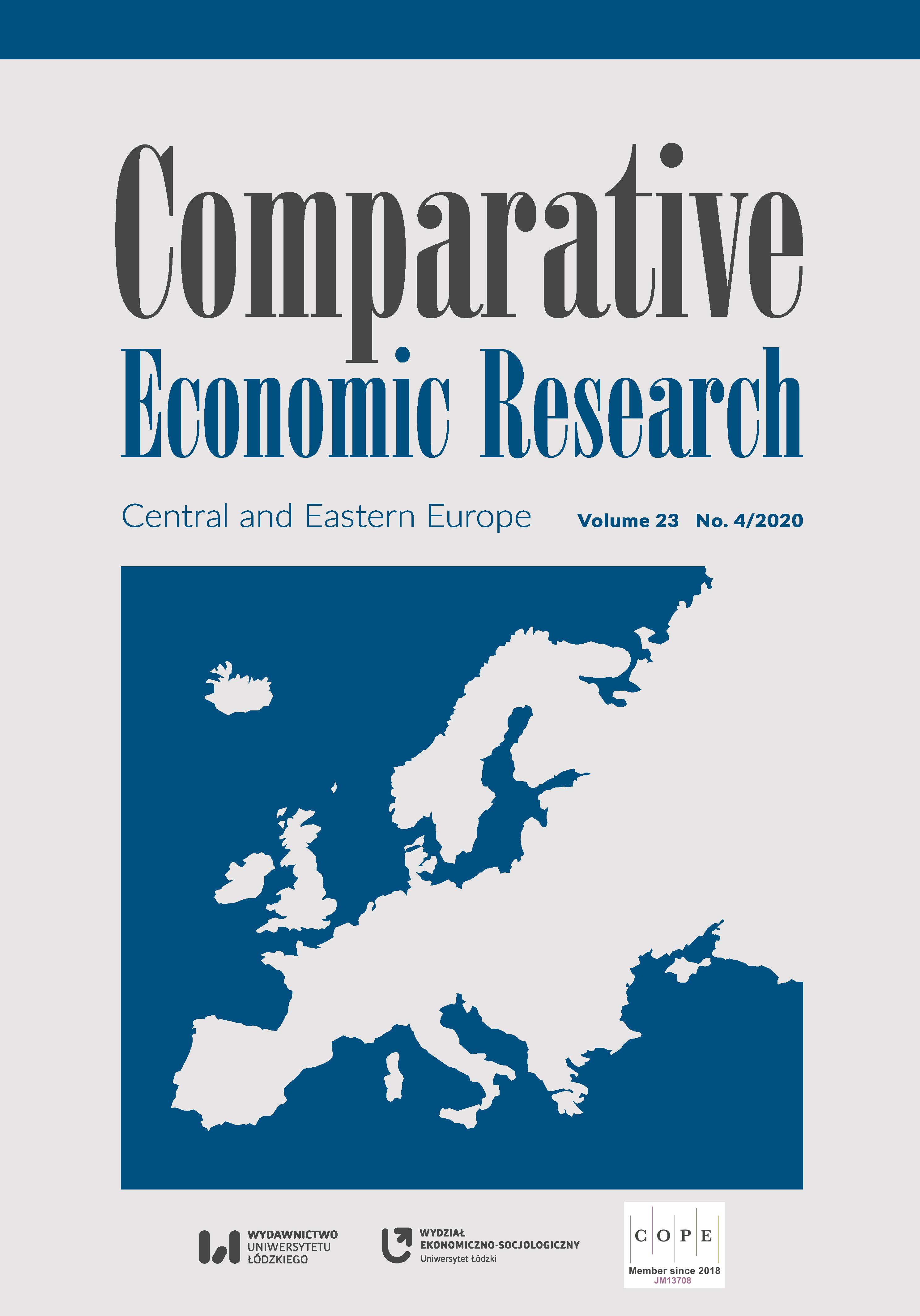Investment in Human Capital Within the Creative Economy Formation: Case of the Eastern and Central Europe Countries
DOI:
https://doi.org/10.18778/1508-2008.23.31Keywords:
human capital, investment in human capital, education, education funding, creative economy, innovation economyAbstract
The purpose of the article is to determine the link between investing in human capital and the formation of the creative economy. Given that human capital is considered both a factor in the socio‑economic development of countries and a prerequisite for the formation of the creative economy and consequently, for the modernization changes in today’s economy, there is a need to study the areas of investment in human capital.
The study is based on an analysis of a number of indicators in Eastern Europe (Ukraine and Moldova) and Central Europe (Poland, the Czech Republic, Romania, Hungary, and Lithuania): total expenditure on education, the analysis of which made it possible to determine the level of education funding in each country; the average cost per pupil/student, which allowed us to identify trends in spending by funding organizations; the share of total expenditure on education in GDP, depending on the level of education, which made it possible to determine the priority and sufficiency of education system funding; the cost allocation indicator by funding organizations; and the human development index, which measures living standards, literacy, education, and longevity. The study also focuses on analyzing data that determine the global innovation index, since its calculation is based on the assessment indicators of human capital and research (education, tertiary education, research, and development) and creative outputs (intangible assets, creative goods, and services, online creativity).
Based on the results of the research, it was concluded that human capital is the main factor that boosts the creative economy, and enhancing human capital depends on the level of education and scientific progress in a country. Empirical evidence shows that directing investment in human capital contributes to the formation of the creative economy, improving the competitiveness of countries, and at the same time, ensuring the appropriate rates of their socio‑economic development.
Downloads
References
Becker, G. (1964), Human Capital, Columbia University Press, New York.
Google Scholar
Bilan, Y., Vasilyeva, T., Kryklii, O., Shilimbetova, G. (2019), The creative industry as a factor in the development of the economy: dissemination of European experience in the countries with economies in transition, “Creativity Studies”, 12 (1), pp. 75–101. https://doi.org/10.3846/cs.2019.7453
Google Scholar
DOI: https://doi.org/10.3846/cs.2019.7453
Creative Economy Outlook (2018), Trends in international trade in creative industries. https://unctad.org/en/PublicationsLibrary/ditcted2018d3_en.pdf (accessed: 19.07.2020).
Google Scholar
Diebolt, C., Hippe, R. (2019), The long-run impact of human capital on innovation and economic development in the regions of Europe, “Applied Economics”, 51 (5), pp. 542–563. https://doi.org/10.1080/00036846.2018.1495820
Google Scholar
DOI: https://doi.org/10.1080/00036846.2018.1495820
Dubik, E., Mityakov, S. (2013), Ynvestycyy v chelovecheskyj kapytal na raznih stadyyah zhyznennogo cykla, “Kreatyvnaya ekonomyka – Creative Economy”, 9 (81), pp. 3–13. https://cyberleninka.ru/article/n/investitsii-v-chelovecheskiy-kapital-na-raznyh-stadiyah-zhiznennogo-tsikla/viewer [in Russian].
Google Scholar
Fischer, S., Dornbusch, R., Schmalensee, R. (1988), Introduction to Macroeconomics, McGraw-Hill Book Company, New York.
Google Scholar
Florida, R. (2002), The Rise of the Creative Class: And How It’s Transforming Work, Leisure, Community and Everyday Life, Basic Books, New York.
Google Scholar
Grachev, S.A., Gundorova, M.A., Moshnov V.A. (2016), Ynvestycyy v chelovecheskyj kapytal. Ucheb. Posobye, Yzd-vo VlGU, Vladymyr [in Russian].
Google Scholar
Harrison, L., Huntington, S. (2000), Culture Matters: How Values Shape Human Progress, Basic Books, New York.
Google Scholar
Herman, E., Suciu, M.C. (2019), Towards a smart, inclusive and sustainable development. Investment in human capital and innovation. An empirical analysis, Proceedings of the International Conference on Business Excellence, Volume 13, Issue 1. https://doi.org/10.2478/picbe-2019-0070
Google Scholar
DOI: https://doi.org/10.2478/picbe-2019-0070
Howkins, J. (2001), The Creative Economy: How People Make Money From Ideas, The Penguin Press, New York.
Google Scholar
Informaciya shhodo finansuvannya osvity i nauky v Ukrayini (2017). http://zet.in.ua/statistika-2/byudzhet/informaciya-shhodo-finansuvannya-osviti-i-nauki-v-ukra%D1%97ni (accesssed: 18.12.2019) [in Ukrainian].
Google Scholar
Kuznets, S. (2001), Biographical Memoirs: Volume 79, The National Academy of Sciences of the United States of America, Washington D.C. https://www.nap.edu/read/10169/chapter/13 (accesssed: 18.12.2019).
Google Scholar
Posnova, T.V. (2018), Kreatyvnyj lyudskyj kapital yak faktor rozvytku innovacijnoyi ekonomiky, “Modern Economics”, 7, pp. 148–157. https://modecon.mnau.edu.ua/issue/7-2018/UKR/posnova.pdf (accesssed: 15.11.2019) [in Ukrainian].
Google Scholar
Salikhov, B. (2017), Kreatyvnij kapytal v ekonomyke znanyj. Monografya, ITK “Dashkov y K”, Moscow [in Russian].
Google Scholar
Schultz, T. (1971), Investment in Human Capital. The Role of Education and of Research, The Free Press, New York.
Google Scholar
Shkurupiy, O.V. (2007), Investyciyi v intelektualno-kreatyvnyj kapital: analogy ta vidminnosti. http://dspace.nbuv.gov.ua/bitstream/handle/123456789/35136/33-Shkurupiy.pdf?sequence=1 (accesssed: 10.11.2019) [in Ukrainian].
Google Scholar
Szara, K. (2019), Technology as a stimulus for the development of creative capital at the local level on the example of municipalities of the Podkarpackie Voivodeship, “Ekonomia i Prawo – Economics and Law”, 18 (4), pp. 499–514. https://doi.org/10.12775/EiP.2019.033
Google Scholar
DOI: https://doi.org/10.12775/EiP.2019.033
The Creative Economy Report. The Challenge of Assessing the Creative Economy: towards Informed Policy-making (2008). https://unctad.org/system/files/official-document/ditc20082cer_en.pdf (accesssed: 25.11.2019).
Google Scholar
The Global Innovation Index (2017). https://www.wipo.int/edocs/pubdocs/en/wipo_pub_gii_2017.pdf (accesssed: 25.11.2019).
Google Scholar
The World Economic Forum (2019). https://www.weforum.org (accesssed: 1.12.2019).
Google Scholar
Throsby, D. (2014), Economics and culture, Cambridge University Press, United Kingdom.
Google Scholar
Vakhovich, I., Chul, O. (2014), Rozvytok kreatyvnyh industrij: regionalnyj vymir. Monografiya, Vezha-Druk, Luczk [in Ukrainian].
Google Scholar
What a performance! Stellar employment boom continues for the UK’s Creative Industries (2017). https://www.gov.uk/government/news/what-a-performance-stellar-employment-boom-continues-for-the-uks-creative-industries (accesssed: 11.11.2019).
Google Scholar
Downloads
Published
How to Cite
Issue
Section
License

This work is licensed under a Creative Commons Attribution-NonCommercial-NoDerivatives 4.0 International License.











